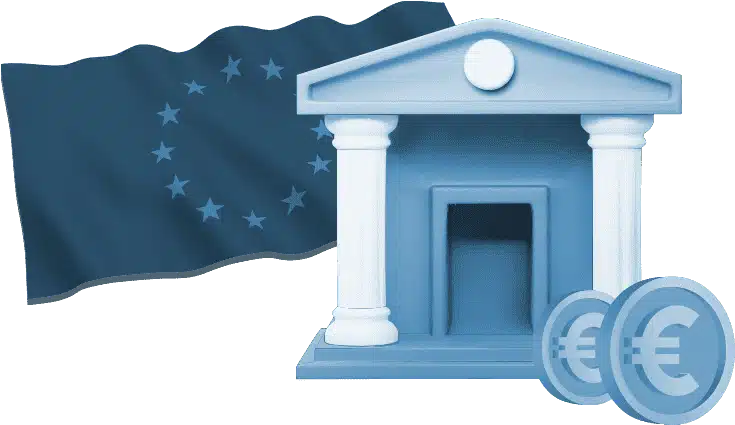European Central Bank

- What is the European Central Bank?
- How does the European Central Bank work?
- Structure of the European Central Bank
- Functions of the European Central Bank
- The ECB in Fundamental Analysis
- How to Trade with ECB Decisions?
Since the fall of the Holy Roman Empire, the European intellectuals have been dreaming the coalescence of European nations to thrive together in a single confederation. The first signals of its realisation came in the early 20th century, which marked a historical era of many economic, political, and scientific unions were formed, some with treaties and some with wars.
The European Union was formally established in 1993 to standardise certain legal systems and create an internal market. In 1998, a monetary union was achieved, though took full effect in 2002, when 12 members started using Euro as a single currency.
See a trading opportunity? Open an account now!
What is the European Central Bank?
The European Central Bank (ECB) is the top monetary institution in the European Union (EU), governing the Euro currency (EUR) and the monetary and financial affairs in the region. It was established on June 1, 1998, as one of the seven EU institutions which were agreed upon in the Treaty of Amsterdam.
The European Union is comprised of 27 member states who agree to share common internal legal and economic systems. 19 of the EU countries accept the Euro as their national currency and collectively known as the Euro Zone.
The ECB’s monetary policies and decisions directly govern the Euro Zone countries, while peripherally influencing monetary issues in the non-Euro countries. Its main functions are to issue Euro, to ensure price stability in the Euro Zone, and to create and conduct monetary and financial policies for the EU.
The ECB is headquartered in Frankfurt, Germany. The Governing Council of the ECB is comprised of the central bank governors of the 19 states in the Euro Zone and six executive board members.
Independent of any political or commercial influence, the ECB is governed by the EU laws and held accountable through public hearings with members of the European Parliament.
How does the European Central Bank work?
Considering the size differences and activity variances of the Euro Zone economies, all operations of the European Central Bank revolve around the price stability principle. The ECB’s main responsibilities are:
- Issuing Euro and setting the ECB interest rates
- Creating a regional monetary policy to maintain price stability across the Euro Zone
- Supervising the banking and other financial operations in the European Union
- Assisting the member states in their economic policies in congruence with the EU objectives
- Supporting employment and economic growth efforts across the region
Structure of the European Central Bank
The structure of the European Central Bank resembles a national parliament as it is comprised of different bodies to propose, decree, and implement decisions.
- Supervisory Board: conducts the bank’s supervisory tasks, like monitoring inflation levels, and proposes decisions in accordance with the monetary policy
- Governing Council: the main decision-making body of the ECB, which decrees the decisions proposed by the Supervisory Board
- Executive Board: implements the decisions approved by the Governing Council and issues operational decisions to national central banks of the member states
The President of the ECB and other members of the executive board are appointed by the Governing Council with the approval of the European Parliament. The bank also has a General Council which assists the member countries in their transition to the Euro. Once all EU members adopt the regional currency, the council will be closed.
Furthermore, all EU members contribute capital to the ECB based on their population and GDP, though non-Euro countries are required to pay less. As such, each EU member holds stocks in the ECB like shareholders of a corporation, but stocks are not transferable nor can be used as collateral.
Functions of the European Central Bank
The European Central Bank mandate administrates the Eurosystem economy and the EU markets. It governs the value of Euro, ensures price stability in the regional markets, and creates an environment for economic growth.
The ECB monetary policy outlines the goals for the Eurosystem economy and guides the bank when evaluating the balance sheet and making decisions to fine-tune the growth process.
The ECB balance sheet consists of the circulating money supply, the reserves held by national central banks (NCBs) and other private financial institutions, and capital requests by credit institutions from the Eurosystem.
In accordance with price stability principle, the ECB monetary policy goals aim to keep the regional inflation level around 2% or below. It is measured with the Harmonised Index of Consumer Prices (HICP), which is the common inflation formula used by all EU countries. If the inflation levels are off the mark, the bank can intervene in the Eurosystem using interest rates, standing facilities, open market operations, and minimum reserve requirements.
The European Central Bank in Fundamental Analysis
As the only issuer of the Euro, the European Central Bank has full control over the currency strength and direct influence on the Euro Zone economies. The ECB meeting for monetary policy occurs every six weeks. In these meetings, the Governing Council evaluates the regional economic conditions, makes the ECB rate decision, and plans other economic interventions, as necessary.
The main economic intervention tool used by the regional central bank is the ECB interest rate. When the ECB rates are raised or cut, the interest rates applied in the transactions between the ECB, NCBs, and financial institutions are modified accordingly. In turn, consumer and corporate loans become more or less expensive, thereby shifting the demand levels and influencing inflation.
ECB Interest Rate Hike
When the EU economy is flourishing, the rapid price inflation can render the level of income and wages insufficient to maintain the standard of living. Thus, salary demands would increase to unaffordable levels and lead to large-scale unemployment.
The ECB can keep the inflation in check by raising interest rates, which would make loans costlier and decrease the available cash in circulation. In turn, the economic demand will slowdown and force sellers to reduce prices.
Higher interest rates would make Euro investments more lucrative and add value to the currency against its counterparts. Safer investment options like savings accounts and bonds of EU countries will offer higher yields. As such, they would attract capital from riskier stock markets where the companies are bearing now-higher costs for corporate loans and might suffer fewer profits from lower consumer activity.
ECB Interest Rate Cut
In times of stagnancy or recession, the ECB can cut the interest rates to stimulate the EU economy. Both citizens and companies would be encouraged by the cost-effective availability of cash and get loans to purchase new items and make new investments. Businesses would expand their operations by enlarging the workforce and decrease the unemployment rate. In turn, people will have the confidence to spend and contribute to the demand economy.
Lower interest rates, however, render Euro cheaper and cause it to lose value in foreign exchange markets. Capital-binding investments become less attractive, and investors would seek to get a slice of the rising corporate profits by investing in the EU stocks and indices.
How to Trade with the European Central Bank Decisions?
The sphere of influence of the European Central Bank includes some of the world’s largest financial markets such as Germany, France, and Italy.
The ECB interest rate decisions have a direct impact on currency pairs like EUR/USD and EUR/GBP; German stocks and indices like Adidas, Bayer, and DAX 30; and French stocks and indices like Carrefour, Peugeot, and CAC 40.
The ECB central bank meetings occur eight times a year. Market players who use news trading strategy for Forex currency pairs and European stocks CFDs follow each occasion closely. The price trends that manifest in the hours before the meeting reflect what ECB decisions are expected by the investors.
At the end of each ECB interest rate meeting, the bank informs the public about the ECB rate decision with an official announcement.
Immediately after, the ECB President holds a press conference to explain the underlying reasons for the decisions and to provide insights about their perspective on the future of the Euro Zone economy.
The ECB meeting minutes are also published but do not contain the hawkish or dovish votes of the Governing Council members.
Under normal economic conditions, if the ECB decides to raise the interest rates as expected by the markets, EUR will gain value in the currency pairs, while European stocks and indices would drop.
The opposite market behaviour will occur if an interest rate cut is decided in line with the forecasts.
However, in extreme economic conditions such as recession, or uncontrollable situations such as pandemics, the ECB can make emergency decisions that are incongruent with the monetary policy, and the markets would react in alignment with the expected control measures.
The ECB interest rate decisions are among the strongest market-moving factors for the European assets, but the impact becomes even more profound when the bank takes the markets by surprise.
Investors often tune into the ECB press conference and read the ECB meeting minutes to gain more information about how the Governing Council sees the future of the economy and take their positions accordingly. Any signals for potentially dramatic decisions in the future can cause even larger volatility in the European assets.
Disclaimer – While due diligence, care and research have been undertaken to compile the above content, it remains an informational and educational piece only. None of the content provided constitutes any form of trade or investment advice or recommendation and should not be construed as such.
Trading the ECB Events with Friedberg Direct, Powered by AvaTrade Technology
The ECB Governing Council makes interest rate decisions only eight times a year. These rare market events are scheduled in advance and generate numerous high-risk & high-return trading opportunities.
Checking the HIPC reports and reviewing the ECB meeting minutes can help to prepare the portfolio for the ECB official interest rate hikes or cuts. The trading strategy for the ECB rate decisions can be further improved by utilising our state-of-the-art trading platforms and advanced technical analysis charts.
- ECB Events Schedule: Learn the schedule of the ECB interest rate decisions and other meetings in the economic calendar.
- Trade on Any Outcome: Different economic conditions, different interest decisions, different market reactions; with CFD trading, you can adapt to all markets with Long and Short positions.
- Most Popular European Assets: Trade EUR/USD and EUR/GBP currency pairs, CFDs on German and French stocks, and prominent EU indices with narrow spreads and better leverage ratios.
- Top-Down Risk Management: Like the ECB managing the risks of the EU economy, you can hedge the risks in your ECB events trading strategy using sound risk management strategies.
The European countries delegated their monetary and financial affairs to the experts of the European Central Bank with confidence. Each interest rate decision by the ECB has a strong impact on the Euro and other European assets.
Now that you know how the ECB takes action and how the markets can be affected by them combine your knowledge with Friedberg Direct’s regulated brokerage services and AvaTrade’s state-of-the-art trading platforms and start thriving in the centuries-old wealth culture of the Europeans.
See a trading opportunity? Open an account now!







